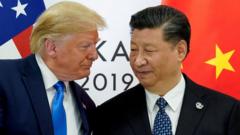China's recent suspension of nearly all rare earth exports since April raises significant concerns regarding global technology production, particularly in sectors reliant on these crucial minerals like automotive and aerospace industries.
China's Rare Earth Export Halt: Impacts and Implications

China's Rare Earth Export Halt: Impacts and Implications
China's freeze on rare earth exports threatens global tech supply chains.
In April 2025, China imposed a near-total ban on the export of seven essential rare earth metals and powerful magnets derived from them. This drastic measure has triggered substantial shortages, endangering operations across various manufacturing sectors in both the United States and Europe. As the world's leading provider of rare earth materials, China's cutoff has posed critical questions about the future of international supply chains.
Rare earth elements consist of 17 different metals located at the bottom of the periodic table. While they are often labeled "rare," these elements are actually found globally but in such low quantities that extracting them efficiently is a challenge. The complexity of refining these minerals, which typically involves over a hundred processing stages and vast amounts of acids, adds to the scarcity.
China’s dominance in the rare earth sector is significant; it accounts for 70% of global rare earth production and 90% of chemical processing. Other countries like the United States and Australia contribute to mining but lack the processing capacity that China has developed. This leads many industries to depend on Chinese supply chains, making the recent export ban a critical concern for manufacturers who now face dwindling stocks of these essential components.
With restrictions on these vital resources, industries reliant on advanced technologies—such as electric cars, wind turbines, and defense systems—are bracing for potential operational shutdowns. The uncertainty surrounding the situation amplifies calls for more localized production and investment in alternative supply sources to reduce future dependence on China.
As the situation evolves, stakeholders worldwide are watching closely, weighing their options to mitigate risks and ensure sustainability in the face of this export shutdown.





















